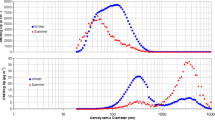Abstract
The short-term dynamics and distribution of airborne biological and total particles have been assessed in a large university hallway by particle counting using laser particle counters and impaction air samplers. Particle numbers of four different size ranges were determined every 2 min over several hours. Bioaerosols (culturable bacteria and fungi determined as colony-forming units) were directly collected every 5 min on Petri dishes containing the appropriate growth medium. Results clearly show distinct short-term dynamics of particulate aerosols, of both biological and non-biological origin. These reproducible periodic patterns are closely related to periods when lectures are held in lecture rooms and the intermissions in between when students are present in the hallway. Peaks of airborne culturable bacteria were observed with a periodicity of 1 h. Bioaerosol concentrations follow synchronously the variation in the total number of particles. These highly reproducible temporal dynamics should be considered when monitoring indoor environments to determine air quality.



Similar content being viewed by others
References
Abt, E., Suh, H. H., Catalano, P., & Koutrakis, P. (2000). Relative contribution of outdoor and indoor particle sources to indoor concentrations. Environmental Science & Technology, 34, 3579–3587. doi:10.1021/es990348y.
Anonymous. (1993). Biological particles in indoor environments. In European Collaborative Action on Urban Air, Indoor Environment and Human Exposure; Report No. 12 (EUR 14988 EN). Brussels: Commission of the European Communities.
Bartlett, K. H., Kennedy, S. M., Brauer, M., van Netten, C., & Dill, B. (2004). Evaluation and determinants of airborne bacterial concentrations in school classrooms. Journal of Occupational and Environmental Hygiene, 1, 639–647. doi:10.1080/15459620490497744.
Brandl, H., Bachofen, R., & Bischoff, M. (2005). Generation of bioaerosols during manual mail unpacking and sorting. Journal of Applied Microbiology, 99, 1099–1107. doi:10.1111/j.1365-2672.2005.02700.x.
Branis, M., Rezacova, P., & Domasova, M. (2005). The effect of outdoor air and indoor human activity on mass concentrations of PM10, PM2.5, and PM1 in a classroom. Environmental Research, 99, 143–149. doi:10.1016/j.envres.2004.12.001.
Colbeck, I. (1995). Particle emission from outdoor and indoor sources. In T. Kouimtzis & C. Samara (Eds.), Airborne particulate matter. The handbook of environmental chemistry (Vol. 4D, pp. 1–33). Heidelberg: Springer.
Cox, C. S. (1995). Physical aspects of bioaerosol particles. In C. S. Cox & C. M. Wathes (Eds.), Bioaerosol handbook (pp. 15–25). Boca Raton: CRC Press Cox.
Dutkiewicz, J., Krysinska-Traczyk, E., Skorska, C., Sitkowska, J., Prazmo, Z., & Urbanowicz, B. (2000). Exposure of agricultural workers to airborne microorganisms and endotoxin handling of various vegetable products. Aerobiologia, 16, 193–198. doi:10.1023/A:1007686910001.
Feller, W. (1950). An introduction to the probability theory and its application. New York: Wiley.
Fierer, N., Liu, Z., Rodriguez-Hernandez, M., Knight, R., Henn, M., & Hernandez, M. T. (2008). Short-term temporal variability in bacterial and fungal populations. Applied and Environmental Microbiology, 74, 200–207. doi:10.1128/AEM.01467-07.
Green, C. F., Scarpino, P. V., & Gibbs, S. G. (2003). Assessment and modeling of indoor fungal and bacterial bioaerosol concentrations. Aerobiologia, 19, 159–169. doi:10.1023/B:AERO.0000006531.35387.bd.
Heikkinen, M. S. A., Hjelmroos-Koski, M. K., Haggblom, M. M., & Macher, J. M. (2005). Bioaerosols. In L. S. Ruzer & N. H. Harley (Eds.), Aerosols handbook (pp. 291–342). Boca Raton: CRC Press.
Jaenicke, R. (2005). Abundance of cellular material and proteins in the atmosphere. Science, 308, 73. doi:10.1126/science.1106335.
Johansson, C., Norman, M., & Gidhagen, L. (2007). Spatial and temporal variations of PM10 and particle number concentrations in urban air. Environmental Monitoring and Assessment, 127, 477–487. doi:10.1007/s10661-006-9296-4.
Lighthart, B. (1997). The ecology of bacteria in the alfresco atmosphere. FEMS Microbiology Ecology, 23, 263–274. doi:10.1016/S0168-6496(97)00036-6.
Lighthart, B., & Shaffer, B. T. (1995). Viable bacterial aerosol particle size distributions in the midsummer atmosphere at an isolated location in the high desert chaparral. Aerobiology, 11, 19–25. doi:10.1007/BF02136140.
Luoma, M., & Batterman, S. A. (2001). Characterization of particulate emissions from occupant activities in offices. Indoor Air, 11, 35–48. doi:10.1034/j.1600-0668.2001.011001035.x.
Morawska, L., He, C., Hitchins, J., Mengersen, K., & Gilbert, D. (2003). Characteristics of particle number and mass concentrations in residential houses in Brisbane, Australia. Atmospheric Environment, 37, 4195–4203. doi:10.1016/S1352-2310(03)00566-1.
Stetzenbach, L. D., Buttner, M. P., & Cruz, P. (2004). Detection and enumeration of airborne biocontaminants. Current Opinion in Biotechnology, 15, 170–174. doi:10.1016/j.copbio.2004.04.009.
Tyndall, J. (1876). The optical deportment of the atmosphere in relation to the phenomena of putrefaction and infection. Philosophical Transactions of the Royal Society of London, 166, 27–74. doi:10.1098/rstl.1876.0002.
Zollinger, M., Krebs, W., & Brandl, H. (2006). Bioaerosol generation during grape stemming and crushing. The Science of the Total Environment, 363, 253–259. doi:10.1016/j.scitotenv.2005.05.025.
Zormann, T., & Jeršek, B. (2008). Assessment ob bioaerosol concentrations in different indoor environments. Indoor and Built Environment, 17, 155–163. doi:10.1177/1420326X08089251.
Acknowledgments
The technical assistance of Mara Bertschi, Deniz Cinek, Anja Fürer, Stefanie Gossweiler, Olivia Sala, and Angela Wyss (students of the Kantonsschule Zurcher Unterland, Bulach, ZH) is gratefully acknowledged. In addition, we thank Annette Hofmann (Department of Environmental Health and Safety, University of Zurich) for her help.
Author information
Authors and Affiliations
Corresponding author
Rights and permissions
About this article
Cite this article
Brandl, H., von Däniken, A., Hitz, C. et al. Short-term dynamic patterns of bioaerosol generation and displacement in an indoor environment. Aerobiologia 24, 203–209 (2008). https://doi.org/10.1007/s10453-008-9099-x
Received:
Accepted:
Published:
Issue Date:
DOI: https://doi.org/10.1007/s10453-008-9099-x




